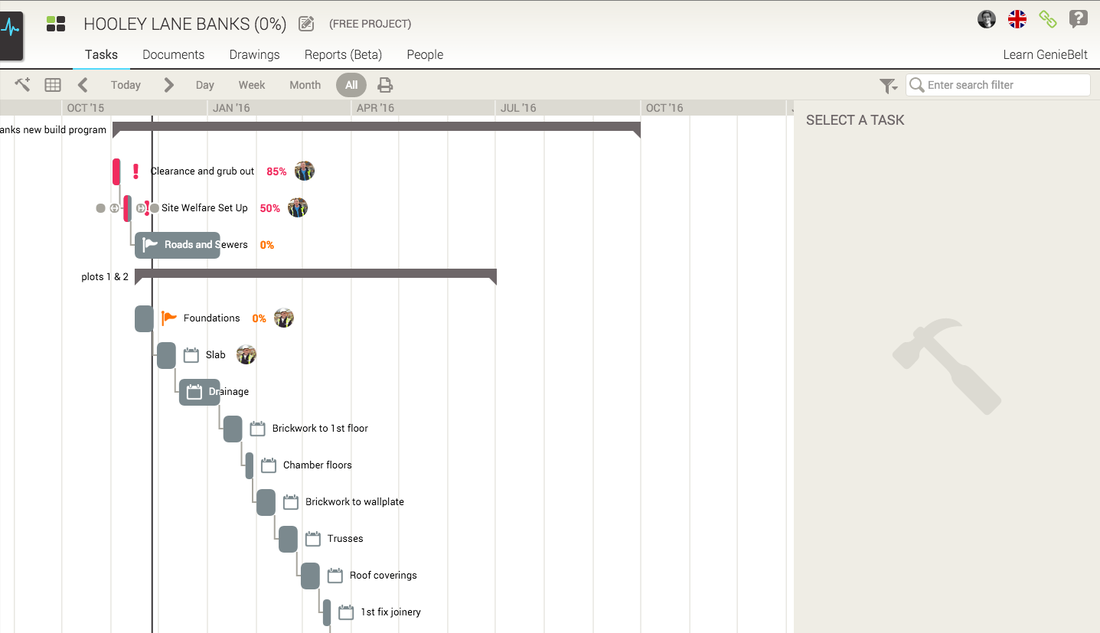 (Guest post from Stuart Howie Senior Advisor to GenieBelt) Way back in the mists of time - well, 1988, actually - I got a job as Site Agent with a housing developer up in Cumbria. It was taking the usual 12 weeks from the contracts being signed to the new, very proud, owners moving into their new homes. The foundations and infrastructure, of course, were already in place for each house before the sales people attracted buyers. With the benefit of hindsight it was a rather boring job with not much to do except keep an eye on the skilled trades and make sure their workmanship was always at an acceptable level. Now, these skilled tradesmen were all on price work. As I chatted with them, they had a common complaint; they couldn’t get in to get work done because they couldn’t get access because someone else was in their way, their materials weren’t on site, or they couldn’t get on our site when we wanted them because they were working elsewhere. I was wandering around the local Library looking for novels I fancied reading when I came across a non-fiction book on Planning. I think I must have found it a bit boring at the time because I can’t remember anything about it. However, it must have put the idea in my head. What happened next was that, on site, I started scribbling ideas on bits of paper to get the hang of this Planning mystery. After that I wandered around asking all the trades how long, or rather, how short a time it would take them to do their bit in each house under ideal conditions. Then the next question was: how to make a decent Programme everyone could look at? Remember, no computers, no plotters back in the day! The biggest pieces of paper I could find were superseded drawings. One went up on the office wall and I wrote all the major Tasks, by hand, on a pretty poor-looking GANNT Chart! This ended up as several Programmes on the wall because there was a new one for each house as a buyer was found. The lads loved me for this! Suddenly start-to-handover was reduced to 6 weeks! The lads were coining it in and could afford foreign holidays for their families! Remember they weren’t a common luxury back in the 1980’s! The only down-side, from my point of view, was that my site walkabouts had to be quicker and more thorough in order to keep pace and make sure my newly-introduced policy of “de-snag as you go” was stuck to! Life moved on and I somehow found myself in commercial construction. It was about the year 2000 when I was Site Manager for an office fit-out in Bristol that I got chance to do more planning of a far more serious nature. It was a very tight time-scale we had to work to and everyone was worried about handing over on time. I became quite infamous on this job, actually! Directors would come on site and say “Look! A site manager - and he’s using a laptop computer!”. Among the software on it was MS Project. I chatted to the subbies’ ganger-men to ask how long each Task would take them; what materials they needed and all the other stuff to be able to make up a Detailed Programme to Completion (DPC). “That was my first experience of planning in a more detailed manner. You have my personal assurance that MSP and PC’s are better for it than paper from old drawings, and that we did finish on time!” The next bit of my education in this planning game was up in the North East on a new prison when I was given the free-lance contract job as a “Planner” for one of the subbies. The sad bit was this was back to hand-drawn DPC’s on superseded drawings! These were better than their predecessors because I could at least copy them from my laptop MSP version. I couldn’t draw them that detailed, of course. However, the main contractor, MACE, had a professional Planner on site. He had a plotter for his programmes! - along with the only other computer on site! Anyway, he gave me lessons and got me really interested. After that I decided to get really clued up on this planning game! These days I have quite an extensive collection of books on the subject. To come up with a good DPC isn’t a quick and easy thing to do. What it requires is that someone has to look at a 2-dimensional (2D) drawing and begin to build it in their head. That requires a quite extensive experience of construction in order to be able to identify quite how that project will be best undertaken. When this is done the Planner has a 3-dimensional (3D) mental model of the project. The next, and final, stage is to get all the Tasks, in the order in which they need to be completed, entered in their planning software. The remaining factor to be considered is how long each of these Tasks will take. A guess based on experience may be sufficient for many of them, but a discussion with the sub-contractors about their views is often advantageous (this by the way was me doing Lean Construction back in the 80s). The other thing that is advisable is to check up on procurement periods for materials. Some may be very long and need entering as a Task for it to be ordered before the start on site. Once all this is done and it is entered on the programming software, with all dependencies indicated, then the Planner has produced a 4-dimensional (4D) model of the project. This will show, and this is particularly important, the Critical Path. These are the Tasks which have to follow each other closely or the whole project will be delayed. Once that is done it is over to the Quantity Surveyors to insert costs and work out their cash flow. In all this, the two main restraints are the start-on-site date and the hand-over date, both of which are contractually obligated. Everything has to happen between those two dates. Similarly restrictive dates can be contractually imposed on sub-contractors. “Successful” construction projects are defined as ones which finish on time, to standards and to budget. They often have the beneficial result of leaving behind “delighted clients” and these are defined as ones who automatically return to you when they have another contract. I had this confirmed to me by a Vice President of Insignia Properties, the second-largest commercial property developer in the U.S.A.. He said he only used four contractors he knew he could rely on! (Side Note, Paul wrote an excellent guest post for GenieBelt titled: The Ultimate Guide To Becoming a Successful Contractor (Well worth a read!) Now we have our DPC and we have a plotter on site. Previously I would have printed off a few cpies of the DPC on the largest size paper the plotter can handle and stuck them up around site. But just like when I moved from drawing my Gantt to using MS Project, now I would import my MS Project programme into GenieBelt. Individual tradesmen like this because it tells them what they should be doing and when and this information is accessible from their phone in their pocket. It also seems to motivate them to work faster than the DPC actually states!  What the site-based planner, site manager or project manager then has to do is, at least once a week, walk around the site and mark up progress for every single Task through a simple swipe of his fingers and all is updated immediately – which saves me time since otherwise I would be marking up progress, importing those paper notes into MS Project and then printing the new DPC. What this up-dating does is allow any slippage to be noted and those Tasks accelerated. If disaster strikes and, for some reason over which there is no control, a Critical Path Task is behind programme, then there has to be a major re-think and the order in which Tasks are completed need to be revised. Because there is a detailed record of who has to do what and by when, and as any over-run for any Task is high-lighted by the software, the finger of blame can easily be pointed if there is any Delay in Completion and hand-over. This fact alone tends to keep all the parties involved committed and compliant. The consequences of Delay are Liquidated and Ascertained Damages (LAD) and they can be horrendous! In my experience £600,000 per month or part thereof is fairly common. To make that worse, to be a week late in Completion might require the Client, under their contract with their existing landlords, to extend their leases on existing rental premises by 3 months! Their only alternative would be to send all their staff on holiday for that week and to stop trading! We’ve now established that a DPC is not a quick and easy thing to do. In consequence expert and experienced Planners are the highest paid personnel in U.K. Construction. However, nobody should be put off compiling their own if there isn’t a Planner available to do it! The more detailed a DPC is, the better it is. However, as I learnt in my early days, even a poor version can make all the difference! If you are a Site or Project Manager and you aren’t supplied with a DPC I urge you to have a go at it and produce your own! We even made GenieBelt free for you to create a DPC! So that is a lot about DPC’s covered; now is the time to get back to the topic :- Why a Detailed Programme to Completion Ensures Project Success. It is my belief that this is the single most important document on any construction project and the reason for that are these! : -
There it is! With a DPC the construction project will be a successful one which finishes on time, to standard and to budget! It may also bring repeat contracts from the same “delighted client”! The reality is that for a commercial construction contract of, say, £5 million, the cost of compiling that DPC by a Planner will be about £20,000. To try to do that construction project without a Detailed Programme to Completion can well end up in actions for LAD and bankruptcy! That makes the investment look a pretty sound one, doesn’t it? Blog written by Stuart Howie Senior Advisor to GenieBelt Stuart has built something like 2,500 houses, refurbished 1,500 homes and been involved in 150 commercial construction contracts on which he spent about £5 billion, and of which a 100 were project turnaround roles! Connect with me on Linkedin To read more on schedules or programmes read: Mistakes that impact construction schedules (programmes) For other useful construction management articles go to the index of construction articles on this website. construction management construction project management
0 Comments
Leave a Reply. |
Archives
June 2024
Note: We welcome genuine comments, especially comments that add additional information to the subject matter in the article. We however reserve the right to remove inappropriate comments, which includes comments that have nothing to do with the subject, comments that include inappropriate language, and comments that are an advertisement for a product or company, or which include an advertising link. Comments must be in English. We will not enter into discussion on why a particular comment was removed.
CategoriesCopyright 2016 - The attached articles cannot be reproduced for commercial purposes without the consent of the author.
The opinions expressed in the attached articles are those of the writer. It should be noted that projects are varied and different laws and restrictions apply which depend on the location of the contractor and the project. It's important that the reader uses the supplied information taking cognisance of their particular circumstances. The writer assumes no responsibility or liability for any loss of any kind arising from the reader using the information or advice contained herein. "I have what I consider some of the best books on construction management."
Books are available from: Amazon.com Amazon.co.uk takealot.com kalahari.com Amazon.in Amazon.de Amazon.fr Amazon.it Amazon.com.au Powell's Fishpond uread bokus Amazon.ca Amazon.es Other retail stores Available in paperback or on Kindle "28 YEARS OF CONSTRUCTION PROJECT MANAGEMENT EXPERIENCE, DEVELOPING SUCCESSFUL CONSTRUCTION PROJECT MANAGERS AND BUILDING SUCCESSFUL CONSTRUCTION COMPANIES"
|




 RSS Feed
RSS Feed




